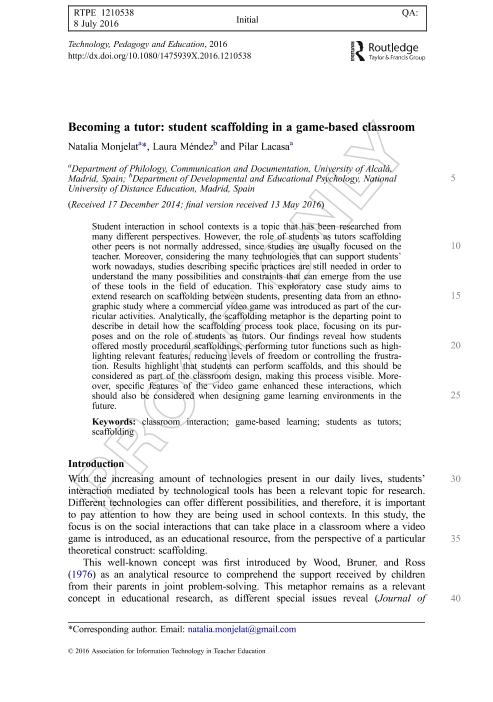Artículo
Becoming a tutor: student scaffolding in a game-based classroom
Fecha de publicación:
08/2016
Editorial:
Routledge
Revista:
Technology, Pedagogy and Education
ISSN:
1475-939X
e-ISSN:
1747-5139
Idioma:
Inglés
Tipo de recurso:
Artículo publicado
Clasificación temática:
Resumen
Student interaction in school contexts is a topic that has been researched from many different perspectives. However, the role of students as tutors scaffolding other peers is not normally addressed, since studies are usually focused on the teacher. Moreover, considering the many technologies that can support students’ work nowadays, studies describing specific practices are still needed in order to understand the many possibilities and constraints that can emerge from the use of these tools in the field of education. This exploratory case study aims to extend research on scaffolding between students, presenting data from an ethnographic study where a commercial video game was introduced as part of the curricular activities. Analytically, the scaffolding metaphor is the departing point to describe in detail how the scaffolding process took place, focusing on its purposes and on the role of students as tutors. Our findings reveal how students offered mostly procedural scaffoldings, performing tutor functions such as highlighting relevant features, reducing levels of freedom or controlling the frustration. Results highlight that students can perform scaffolds, and this should be considered as part of the classroom design, making this process visible. Moreover, specific features of the video game enhanced these interactions, which should also be considered when designing game learning environments in the future.
Palabras clave:
Classroom Interaction
,
Game-Based Learning
,
Scaffolding
,
Students as Tutors
Archivos asociados
Licencia
Identificadores
Colecciones
Articulos(IRICE)
Articulos de INST.ROSARIO DE INVEST.EN CS.DE LA EDUC. (I)
Articulos de INST.ROSARIO DE INVEST.EN CS.DE LA EDUC. (I)
Citación
Monjelat, Natalia Gabriela; Méndez, Laura Marcela; Lacasa, Pilar; Becoming a tutor: student scaffolding in a game-based classroom; Routledge; Technology, Pedagogy and Education; 26; 3; 8-2016; 265-282
Compartir
Altmétricas




